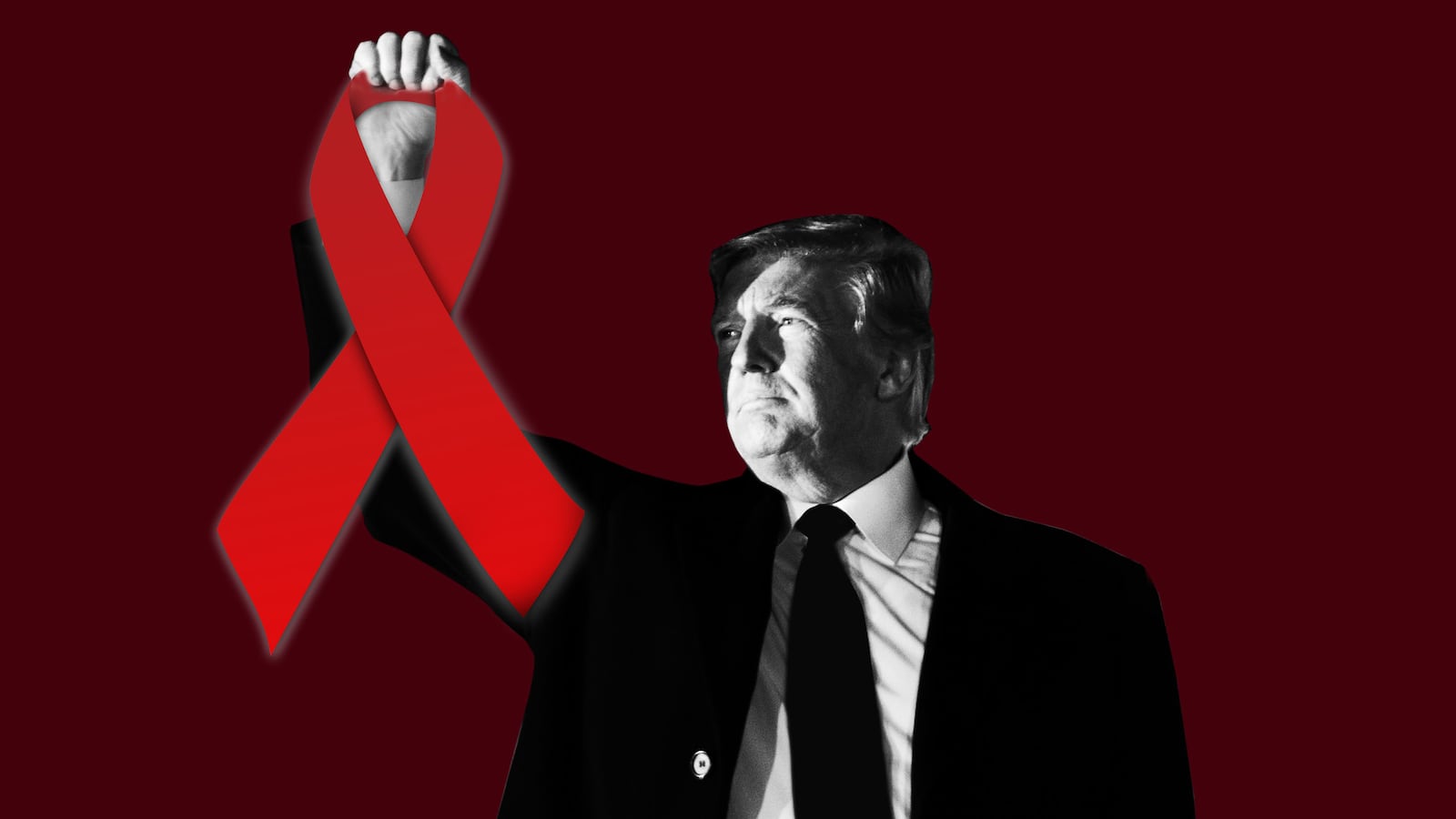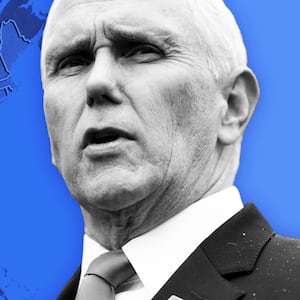In his State of the Union address on Tuesday night, President Donald Trump pledged to end new HIV transmissions by 2030. HIV/AIDS policy experts say that’s a bold goal—but one that the administration itself could undermine through its other actions.
“In recent years we have made remarkable progress in the fight against HIV and AIDS,” said Trump. “Scientific breakthroughs have brought a once-distant dream within reach.”
The president then referenced his forthcoming budget for the 2020 fiscal year, which is expected to be released in March.
“My budget will ask Democrats and Republicans to make a needed commitment to eliminate the HIV epidemic in the United States within 10 years,” Trump promised. “We have made incredible strides, incredible. Together we will defeat AIDS in America and beyond.”
Politico first reported that Trump would make the pledge, under advisement from the Department of Health and Human Services and the Centers for Disease Control and Prevention.
HIV/AIDS advocacy groups celebrated the overall goal of ending the epidemic by 2030. In a statement, over a dozen such groups—including AIDS United, the Southern AIDS Coalition, and Gay Men’s Health Crisis—said that they were “cautiously encouraged” by Trump’s remarks.
But primarily, they warned that President Trump will have to put his money where his mouth is when it comes to HIV prevention: “We stand ready to work with him and his administration if they are serious. But to date, this administration’s actions speak louder than words and have moved us in the wrong direction.”
Most recent among these actions is a proposed rule change to Medicare Part D benefits, which HIV/AIDS experts warn could make it more difficult for people currently living with HIV to start anti-retroviral therapy, or ART.
Jeffrey Crowley, who served as director of the Office of National AIDS Policy from 2009 t0 2011 and now leads the infectious disease program at Georgetown Law, told The Daily Beast that the new proposal for Part D from the Centers for Medicare & Medicaid Services—first published in late 2018– is “almost zeroed in on harming access to anti-retrovirals for people with HIV, so that’s really problematic.”
Part D insurance plans are required to cover ART for people living with HIV but, as HIV Medicine Association chair W. David Hardy noted in a recent article for the health news website STAT, the CMS’s proposed rule change would essentially allow “[insurers] to impose obstacles to some drugs based on cost.”
Under the new rule, as Hardy summarized, doctors would be required to receive prior authorization from insurers before beginning treatment—and patients would be required to try cheaper drugs before being granted access to more costly ones.
In other words, if the proposed rules go into effect, people living with HIV could face delays starting ART—even though the government’s own AIDS information website notes that people with HIV ‘should start ART as soon as possible”—and could be forced to accept potentially ineffective treatment at first.
Jesse Milan, Jr., president of AIDS United, told The Daily Beast that the Part D rule change “could have a very deleterious effect on people who are living with HIV who are on Medicaid—and we’re talking about potentially several hundred thousand.”
According to the Kaiser Family Foundation, “approximately one quarter of people with HIV in care get their health insurance coverage through Medicare.” (The government estimates that 1.1 million people are living with HIV, although not all are in treatment; in fact, one out of seven don’t know they have it.)
Making HIV treatment harder for people on Medicare could also impede prevention efforts.
Treatment for people living with HIV is essential for stopping new transmissions. In addition to allowing someone living with HIV to lead a longer life, ART can also reduce a person’s viral load to such a low level that they can no longer transmit the virus to others people As the CDC now acknowledges, there is “effectively no risk” for HIV transmission through sexual intercourse for those taking ART as prescribed.
“It’s a big win for ending the epidemic when we get people appropriately on HIV treatment,” said Milan, Jr.
But potential changes to Medicare Part D are not the only reason why HIV/AIDS experts and advocates are concerned about Trump meeting his 2030 goal. They also warn that the administration’s hostility to the Affordable Care Act—and to LGBT people more generally—could get in the way of ending new HIV transmissions.
Gay and bisexual men account for the majority of new HIV diagnoses in the United States—and black gay and bisexual men are most impacted. Transgender women are also at heightened risk for contracting HIV. Maintaining a strong relationship with the LGBT community, experts say, is essential for any HIV prevention efforts.
But the Trump administration to date has taken a long list of anti-LGBT actions, such as attempting to ban transgender people from military service and siding with health care providers who would deny service to LGBT people in the name of “religious freedom.”
Crowley, for one, worries that the Trump administration’s HIV prevention efforts could lean too heavily on a geographic focus on heavily-impacted regions like the South without actually naming the specific groups who are most affected, like gay and bisexual men. (According to the early report from Politico, the Trump administration’s HIV strategy would at first focus on “the roughly 20 states where the most HIV infections occur,” primarily in the South.)
“To any extent that there’s a geographic focus, there is a much greater population focus because two percent of the population [gay and bisexual men] are 70 percent of the cases,” he told The Daily Beast. “If their politics don’t let them talk about gay and bisexual men or trans people, that’s problematic.”
In 2017, as The Daily Beast previously reported, the White House’s World AIDS Day proclamation made no mention of LGBT people, let alone LGBT people of color.
The 2018 World AIDS Day proclamation also made no mention of LGBT people.
Nor did Trump specifically mention the impact of HIV on gay and bisexual men during his State of the Union address.
Meanwhile, CDC resources continue to stress that black gay and bisexual men are most impacted. That has left HIV/AIDS groups feeling like they’re getting mixed messages from the federal governments.
“We’re looking for some consistency,” Milan, Jr. told The Daily Beast, “and perhaps this [pledge] might be an opportunity for consistency to actually start occurring.”
Milan, Jr. says that the White House’s anti-LGBT record “does give us great concern,” but he would still welcome the administration backing up its pledge with action.
“We’re hopeful that the president fuels the political will to end the epidemic,” he said, “but we’re looking for the resources to make it possible.”
Experts and advocacy groups alike believe the United States is at a critical turning point in the fight against HIV thanks to advancements in ART and the development of pre-exposure prophylaxis, or PrEP—a once-daily preventative medication that dramatically reduces the risk of getting HIV. (These are the most important of the “scientific breakthroughs” that Trump referenced in his State of the Union address.)
With ART and PrEP—and widened access to them—AIDS United believes the domestic HIV epidemic could be ended as soon as 2025, five years earlier than Trump’s pledge.
Even more dramatic scientific breakthroughs could be coming soon.
“For the majority of people with HIV, the standard of care is one pill once a day, which is a remarkable advancement, and the standard of care for preventing HIV is a pill a day,” Crowley told The Daily Beast. “But we’re on the cusp of game-changing changes.”
Those game-changers include long-acting products that could be taken less frequently, or even implanted under the skin.
“We’re quickly going to be entering an era where people won’t have to treat HIV daily, or where they won’t have to take something to prevent it daily,” said Crowley. “It could be that a few times a year you go to your doctor and get a shot.”
This cutting-edge research is largely funded by pharmaceutical companies, but the National Institutes of Health also plays a significant role in funding HIV/AIDS research.
President Trump has proposed massive cuts to the NIH but Congress has resisted those efforts—and as Vox reported last year, NIH funding has actually managed to grow under the Trump administration. Still, advocacy groups perceive the budget proposals as a signal that the Trump administration doesn’t consider ending HIV to be a priority.
“If Trump was serious about HIV, he wouldn’t have proposed HIV funding cuts in his first two budgets,” National LGBTQ Task force advocacy director Stacey Long Simmons said in a statement issued before Trump’s address. “If Trump was serious about helping those with HIV and reducing the transmission of HIV, he wouldn’t have abruptly dismissed the presidential council on HIV and left the council vacant for nearly a year.”
Indeed the list of HIV-related grievances that advocacy groups highlighted in advance of the State of the Union address dates back to nearly the beginning of the administration. President Trump’s first budget in 2017 included proposed cuts for HIV/AIDS funding.
Then, in June 2017, approximately one quarter of the Presidential Advisory Council on HIV/AIDS, or PACHA, resigned, writing in a letter published by Newsweek that Trump “simply does not care” about people living with HIV. That December, the remaining PACHA members were fired via overnight letters from FedEx.
PACHA continued to be vacant until December 2018, when two co-chairs were named to the panel—but the remainder of the seats have yet to be filled.
That history has left many HIV/AIDS and LGBT advocacy groups looking for proof that the Trump administration wants to do more than just talk about ending the epidemic. They say that the White House has two opportunities to prove how serious it is, one immediate, and one in March when the budget is released.
“They can start by withdrawing the proposed rule change to Part D’s protected classes [of drugs],” the dozen-plus groups, including AIDS United, wrote in their statement. “But the real proof will be in the President’s 2020 budget request next month.”
That’s when we’ll know how much of a financial commitment the Trump administration is willing to make to back up the president’s promise.







